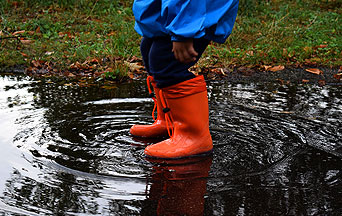
A puddle used to be a normal result of an afternoon shower. Water would accumulate and run off to streams and rivers. No one thought about puddles as something significant.
That was before environmentalists defined such puddles as protected bodies of water. The 2015 Clean Water Rule (CWR) declared puddles and streams must be under government regulation.
The good news is that the Trump Administration has just repealed this infamous water rule passed by the Obama administration. Puddles can be puddles again.
The Effort for Water Quality
The effort to maintain clean water in America began with the 1948 Federal Water Pollution Control Act. Its goal was to regulate the discharge of pollutants and establish standards of quality for surface waters.
In 1972, the Clean Water Act expanded the reach of government action by giving the Environmental Protection Agency (EPA) the authority to implement control programs and set water quality. It also set standards for all contaminants in surface waters and made the discharge of a pollutant a punishable offense without a permit and funded the building of sewage plants with federal grants.
10 Razones Por las Cuales el “Matrimonio” Homosexual es Dañino y tiene que Ser Desaprobado
The overall results of this action were positive since it led to the reduction or elimination of pollutants and cleaner water. Although there were exceptions to the rule, the CWA did not clash with commonsense water and property rights. The EPA did not infringe upon the rights of landowners to create and use irrigation ditches, stock ponds and seasonal run-off.
The Clean Water Rule Changes Everything
This changed with the CWR. While the EPA claimed that they were regulating water, that water was located on land. The EPA said the new rules allowed them to regulate sixty percent of all streams and the surrounding area. Millions of acres of “wetlands” or soggy lands were subjected to its new overreaching regulations.
The EPA’s definition of wetlands was any land wet enough to support the growth of “water-tolerant” plants. It also included all “newly regulated streams,” which means those currents that channel water only when it rains. Thus, even a dry stream bed fell under its regulation.
Eternal and Natural Law: The Foundation of Morals and Law
As a consequence, a slight depression in the soil (a puddle) could gather water and suffer the discharge of a “pollutant.” The definition of pollutant is broad enough to include soil, vegetation, rocks and any disturbance of the land. Adding any of these elements to the puddle could be called a crime punishable by law with fines.
For those engaged in agriculture, industrial or residential development, such restrictions are a nightmare.
 Learn All About the Prophecies of Our Lady of Good Success About Our Times
Learn All About the Prophecies of Our Lady of Good Success About Our Times
The Pushback From Owners
The new rule caused strong pushback from business owners and farmers across the U.S. It unleashed a barrage of lawsuits and complaints. Examples of negative repercussions are the following statements:
The American Farm Bureau claimed the agencies “failed to listen to concerned farmers, ranchers and business owners around the country in crafting its new rule … making it impossible for farmers and ranchers to look at their land and know what can be regulated.”1
The Small Business Administration said that “The rule will have a direct and potentially costly impact on small businesses. The limited economic analysis that the agencies submitted with the rule provides ample evidence of a potentially significant economic impact.”2
The National Association of Counties claimed that “The flawed consultation process has resulted in a final rule that does not move us closer to achieving clean water goals and creates more confusion than clarity.”3
Finally, the National Federation of Independent Business declared that the rule “has the potential to bring local development to a stop and make it much more difficult for small businesses to make even minor improvements to their properties.”4
A Lack of Clarity
When the CWR was implemented, President Obama said “This rule will provide the clarity and certainty businesses and industry need about which waters are protected by the Clean Water Act, and it will ensure polluters who knowingly threaten our waters can be held accountable…”5
Slashing the Green Stranglehold on American Infrastructure
Sadly, there was no discernable clarity, but only confusion aggravated by the EPA’s open interpretation of the law.
At the time, Speaker of the House John Boehner replied, “[t]he administration’s decree to unilaterally expand federal authority is a raw and tyrannical power grab that will crush jobs. … “[T]he rule is being shoved down the throats of hardworking people with no input, and places landowners, small businesses, farmers and manufacturers on the road to a regulatory and economic hell.”6
In putting millions of acres under its control, the socialist-leaning Obama administration showed little concern for individual property or water rights. Under the guise of providing cleaner water, the CWR overreached federal authority by seeking to control even the smallest “bodies” of water, such as puddles. By repealing the rules, the Trump Administration is attempting to give the proper balance to provide for clean water without violating property rights or stifling the economy.
Science Confirms: Angels Took the House of Our Lady of Nazareth to Loreto
Much work must still be done to iron out the details of what constitutes Waters of the United States (WOTUS) and how to protect them properly. However, the scrapping of these arbitrary rules is an excellent first step toward freeing the economy from the environmentalist stranglehold. It will let puddles be puddles again and save the real work of cleaner water to the waters that really matter.
Footnotes
- https://www.fb.org/issues/regulatory-reform/clean-water-act
- https://www.sba.gov/sites/default/files/5.19.15_WOTUS_Testimony.pdf
- http://www.naco.org/sites/default/files/RulepublicationsStatement.pdf
- https://www.denverpost.com/2015/06/15/guest-commentary-new-epa-rule-not-good-for-colorado/
- https://obamawhitehouse.archives.gov/the-press-office/2015/05/26/statement-president-clean-water-rule
- https://gohmert.house.gov/news/documentsingle.aspx?DocumentID=398220

